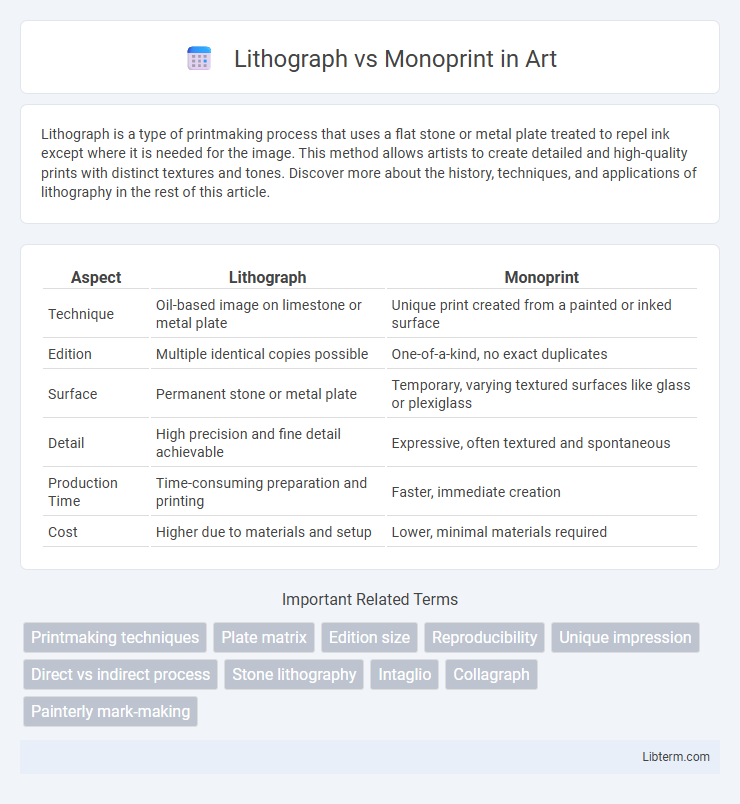Lithograph is a type of printmaking process that uses a flat stone or metal plate treated to repel ink except where it is needed for the image. This method allows artists to create detailed and high-quality prints with distinct textures and tones. Discover more about the history, techniques, and applications of lithography in the rest of this article.
Table of Comparison
| Aspect | Lithograph | Monoprint |
|---|---|---|
| Technique | Oil-based image on limestone or metal plate | Unique print created from a painted or inked surface |
| Edition | Multiple identical copies possible | One-of-a-kind, no exact duplicates |
| Surface | Permanent stone or metal plate | Temporary, varying textured surfaces like glass or plexiglass |
| Detail | High precision and fine detail achievable | Expressive, often textured and spontaneous |
| Production Time | Time-consuming preparation and printing | Faster, immediate creation |
| Cost | Higher due to materials and setup | Lower, minimal materials required |
Introduction to Lithograph and Monoprint
Lithograph is a printing technique based on the repulsion of oil and water, using a flat stone or metal plate treated to retain ink only on the drawn areas, enabling high-quality, detailed reproductions. Monoprint is a unique printmaking process producing a single impression from a prepared plate, often combining painting and printmaking techniques for one-of-a-kind textures and color effects. Both methods offer distinct artistic possibilities: lithography excels in precise line work and tonal gradations, while monoprint emphasizes spontaneity and singularity.
Understanding Lithography: Techniques and Process
Lithography is a printmaking technique based on the immiscibility of oil and water, where artists draw images with a greasy substance on a flat limestone or metal plate. The surface is then chemically treated to fix the drawing and repel ink from non-image areas while retaining it in the drawn sections. This meticulous process allows for fine detail and subtle gradations in tone, distinguishing lithographs from monoprints, which typically involve unique, one-off impressions without such chemical preparation.
What is Monoprint? Key Features and Methods
Monoprint is a unique printmaking technique where each impression produces a single, original image, characterized by its one-of-a-kind quality unlike multiples in lithography. Key features include the use of a smooth, non-absorbent surface such as a metal or glass plate, which artists manipulate with ink or paint before transferring the image to paper. Common methods involve applying ink with brushes, rollers, or stencils, allowing for spontaneous texture and color variations that highlight the creative process.
Historical Backgrounds: Lithography vs Monoprint
Lithography originated in the late 18th century, developed by Alois Senefelder as a planographic printing technique using the principle of oil and water repulsion, revolutionizing mass image reproduction and commercial printing. Monoprint, emerging earlier but gaining distinct recognition in the 17th century, is characterized by unique, one-of-a-kind prints created by applying ink or paint to a smooth surface, often resulting in singular artistic impressions. While lithography enabled repeatable prints through chemically treated stones or plates, monoprint remains valued for its spontaneity and singularity, reflecting differing artistic and commercial intents throughout history.
Materials and Tools for Each Technique
Lithograph materials include a flat limestone or metal plate, greasy crayons or tusche for drawing, and acid solution for etching the image into the surface. Monoprint uses a smooth non-absorbent surface such as glass or a metal plate, oil-based or water-based inks, and brayers or brushes to apply and manipulate ink. The key difference lies in lithography's reliance on chemical processes to create multiple prints, while monoprinting produces unique impressions through hand-applied ink variations.
Key Differences in Artistic Expression
Lithograph relies on a limestone or metal plate prepared with a greasy substance to create multiple consistent prints, enabling artists to reproduce sharp lines and rich textures with high detail precision. Monoprint produces unique, one-of-a-kind images by applying ink or paint directly to a smooth surface, emphasizing spontaneity and expressive brushwork that cannot be exactly duplicated. The key difference in artistic expression lies in lithograph's capacity for replication and fine detail versus monoprint's emphasis on individuality and dynamic, unpredictable marks.
Advantages and Limitations of Lithography
Lithography offers high image quality and the ability to produce numerous consistent prints, making it ideal for detailed artwork and commercial purposes. Its limitations include the complexity of surface preparation and sensitivity to moisture, which can affect print consistency. Compared to monoprints, lithographs provide reproducibility but lack the unique, one-of-a-kind characteristics inherent in monoprint art.
Pros and Cons of Monoprinting
Monoprinting offers unique advantages such as the ability to create one-of-a-kind prints with rich textures and organic variations, fostering artistic experimentation. However, its limitations include lower reproducibility and less precision compared to lithography, making it less suitable for mass production where consistency is critical. The tactile quality and spontaneity of monoprints appeal to artists seeking individuality, though it requires more hands-on skill and can be time-consuming.
Choosing the Right Method for Your Artwork
Lithograph and monoprint techniques offer distinct artistic qualities, with lithographs providing detailed, repeatable prints using a stone or metal plate, ideal for precise and consistent imagery. Monoprints create unique, one-of-a-kind prints through direct manipulation of ink on a plate, perfect for artists seeking spontaneity and singular expression. Choosing the right method depends on whether your artwork prioritizes reproducibility and fine detail or originality and textural variation.
Conclusion: Lithograph or Monoprint—Which Suits You Best?
Choosing between lithograph and monoprint depends on your artistic goals and desired outcomes. Lithographs offer precise reproduction of detailed images with consistent quality, ideal for artists seeking multiple identical prints. Monoprints provide unique, one-of-a-kind impressions with textured, expressive qualities, perfect for those valuing originality and spontaneity in their artwork.
Lithograph Infographic

 libterm.com
libterm.com